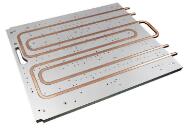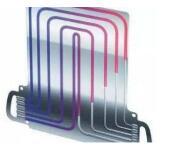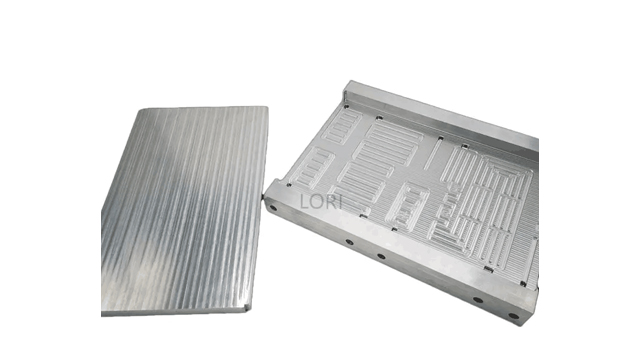Cold plates are similar to radiators in air-cooled or natural cooling systems and are relatively variable components in liquid cooling designs. Other components such as pumps, quick connectors, expansion tanks, degassing tanks, filters, and even heat exchangers can often be selected from existing product lines based on a few key parameters. Therefore, this chapter focuses on the design of cold plates.
When designing a cold plate radiator, the basic considerations are as follows:
- Enhance heat transfer by increasing the contact area between solids and fluids within a given volume.
- Use thermal interface materials to make contact with the heat source.
- Ensure there is a contact surface between the fluid and the solid.
- Heat from the source is first transferred to the cold plate and then to the liquid medium flowing through the cold plate, which carries it out of the system.
Clearly, the design steps and considerations for cold plates are similar to those for radiators in air-cooled or natural cooling devices, except that the fluid medium in cold plates is liquid, whereas, in forced air or natural cooling, the medium is gas. This can be seen in the following design steps:
1.Calculate Flow Rate
Before designing a cold plate, you need to estimate the flow rate required for system cooling, similar to estimating airflow requirements before designing an air-cooling system.
2.Determine Cold Plate Material
In addition to cost, availability, and processability, the selection of cold plate material should also focus on the following aspects:
①Thermal Conductivity:
Common materials for cold plates are copper (alloy) and aluminum (alloy), both of which have high thermal conductivity. In fact, most metal components that play a major role in heat dissipation in electronic products are either copper (alloy) or aluminum (alloy).
②Chemical Compatibility with the Liquid Medium:
Similar to pumps, the cold plate must ensure chemical compatibility with the liquid medium. Typically, electrochemical reactions between the liquid medium and the cold plate are unavoidable. To reduce corrosion rates, corrosion inhibitors can be added to the medium. Corrosion inhibitors are substances or compounds that prevent or slow down material corrosion when present in an environment (medium) at appropriate concentrations. After determining the materials in direct contact with the liquid cooling medium, choose suitable inhibitors based on material properties.
③Density:
For products requiring lightweight design, materials with lower density should be used. In such cases, aluminum is a very common choice. For example, the cold plates in power battery packs of new energy vehicles are typically made of aluminum alloy.
④Freezing Point and Boiling Point:
The liquid cooling medium must remain liquid within the environmental temperature range of the product. If the freezing point of the medium is too high, it may solidify in lower temperatures, preventing circulation and causing system failure. Conversely, if the boiling point is too low, the liquid may boil into gas at higher temperatures, leading to system instability.
3. Flow Channel Design
In air-cooled systems, the internal layout of heat-generating components and the addition or reduction of structural elements are used to control the airflow direction and transfer efficiency. In liquid cooling systems, the flow direction of the liquid can be strictly controlled through piping.
Similar to airflow in air-cooled systems, the direction of liquid flow in liquid cooling systems directly affects heat transfer direction and efficiency. When designing the flow channels for cold plates, consider the following factors:①Heat Source Distribution: The fluid should be as close to the heat source as possible to reduce thermal resistance.
②Structural Clearance: Flow channels need to maintain a safe distance from fixed holes on the cold plate.

③Uniform Layout: The fluid should flow evenly across the cold plate to effectively utilize the heat dissipation area. Typically, the farther a region is from the flow channel, the less it contributes to heat dissipation.

④Control Flow Rate: The eroding effect of the medium on the radiator worsens with increased flow rate, and flow resistance also increases rapidly. However, a higher flow rate generally results in a higher convective heat transfer coefficient. The flow rate should be balanced with cooling requirements and available space.
⑤Minimize Flow Resistance: Design serial and parallel flow channels to reduce flow resistance and leakage risks.
⑥Processability and Cost:Pressure Relief and Alarms: Pressure sensors and temperature sensors should be placed at appropriate locations in the piping to monitor the system in real-time. Take necessary control measures in case of abnormal pressure or temperature.
4.Types of Cold Plates and Their Pros and Cons
Liquid cooling systems have a broad range of applications with varied product characteristics. Different types of cold plates are required based on specific needs. Common cold plate types include drilled, embedded tube, vapor chamber, milled channel, extended surface, and microchannel. Their advantages and disadvantages are summarized as follows:
Cold Plate Types
- Drilled:
- Pros: Simple processing; heat-generating components can be placed on both sides of the plate.
- Cons: Internal channels are created by mechanical drilling, which is inefficient; only simple channel designs can be used, leading to higher flow resistance; channel cross-sections are limited to circular.
- Embedded Tube:
- Pros: Simple processing, high production efficiency, lower cost.
- Cons: Possible contact thermal resistance between the embedded tubes and the base plate; channel shapes are achieved by bending tubes; tube material may differ from the base plate material, avoiding corrosion; channel shape is affected by tube bending radius—smaller radius increases flow resistance.

- Vapor Chamber:
- Pros: High production efficiency, low cost; flexible channel design, large surface contact between fluid and metal wall, high heat transfer efficiency.
- Cons: Single-side blind holes, which can be located anywhere without interfering with the channel; thicker base plate makes the cold plate heavy; components need to be placed on the thick plate side, leading to higher thermal resistance.
- Milled Channel:
- Pros: Very flexible channel design, can match heat transfer requirements; heat sources can be placed on both sides; vacuum brazed or friction stir welded milled channel cold plates have good sealing.
- Cons: Welding-type milled channel cold plates are complex to manufacture and have low production efficiency; non-welding types have difficult sealing.

- Extended Surface:
- Pros: High heat transfer efficiency; high production efficiency.
- Cons: High flow resistance; high requirements for the liquid cooling medium, which may lead to clogging.
- Microchannel:
- Pros: Highest heat transfer efficiency; fluid flows over the entire cold plate surface, with good temperature uniformity; lightweight and thin.
- Cons: High flow resistance; high requirements for the liquid cooling medium, which may lead to clogging.
In Summary
Liquid cooling design features many differences from air cooling. This chapter describes the differences in liquid cooling design solutions, outlines the design steps, and highlights key considerations. Cold plates are crucial components in liquid cooling design and significantly influence the forms of liquid cooling mediums, pumps, heat exchangers, etc. Due to the variety of forms, Section 5 provides a detailed discussion of cold plate design methods. As product power densities increase, liquid cooling will become more prevalent. The complexity and considerations of its design are substantial. System-level liquid cooling designs in industrial equipment may even need to account for the characteristics of the building itself. Due to limitations, this chapter only covers the most critical aspects closely related to temperature control. Interested readers can contact the author for discussions on specific issues.








